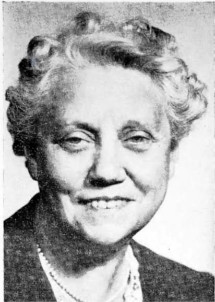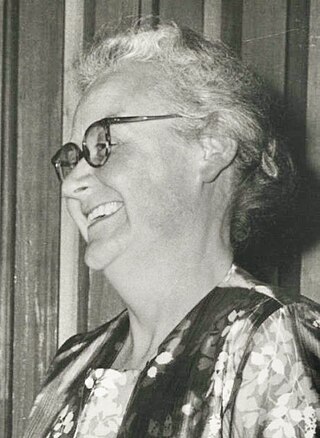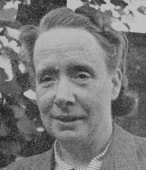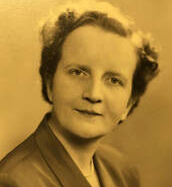Related Research Articles

Beatrice Alice Hicks was an American engineer, the first woman engineer to be hired by Western Electric, and both co-founder and first president of the Society of Women Engineers. Despite entering the field at a time where engineering was seen as an inappropriate career for a woman, Hicks held a variety of leadership positions and eventually became the owner of an engineering firm. During her time there, Hicks developed a gas density switch that would be used in the U.S. space program, including the Apollo Moon landing missions.

The Women's Engineering Society is a United Kingdom professional learned society and networking body for women engineers, scientists and technologists. It was the first professional body set up for women working in all areas of engineering, predating the Society of Women Engineers by around 30 years.

Verena Winifred Holmes was an English mechanical engineer and multi-field inventor, the first woman member elected to the Institution of Mechanical Engineers (1924) and the Institution of Locomotive Engineers (1931), and was a strong supporter of women in engineering. She was one of the early members of the Women's Engineering Society, and its president in 1931. She was the first practising engineer to serve as president of the society.

The history of women in engineering predates the development of the profession of engineering. Before engineering was recognized as a formal profession, women with engineering skills often sought recognition as inventors. During the Islamic Golden Period from the 8th century until the 15th century there were many Muslim women who were inventors and engineers, such as the 10th-century astrolabe maker Al-ʻIjliyyah.
Nancy Burr Deloye Fitzroy was an American engineer specializing in heat transfer and fluid dynamics. She was one of the first female helicopter pilots.

Yvonne Y. Clark was a pioneer for African-American and women engineers. Also known as Y.Y., she was the first woman to earn a Bachelor of Science degree in mechanical engineering at Howard University, the first woman to earn a master's degree in Engineering Management from Vanderbilt University, and the first woman to serve as a faculty member in the College of Engineering and Technology at Tennessee State University, afterward becoming a professor emeritus.

Katharine Stinson (1917-2001) was an American aeronautical engineer and the Federal Aviation Administration's first female engineer.

Gertrude Lilian Entwisle was an electrical engineer. She was the first British woman to retire from a complete career in industry as a professional engineer; the first female engineer to work at British Westinghouse; and the first female student, graduate, and associate member of the Institution of Electrical Engineers. Entwisle was known for her work on designing DC motors and exciters. Her obituary said she broke "barriers of prejudice to become a respected designer of electrical rotating machinery."

Lois Graham was a professor of thermodynamics and cryogenics. She was the first woman to earn a mechanical engineering PhD in the United States.

Isabel Helen HardwichMInstP was an English electrical engineer, an expert in photometry, and fellow and president of the Women's Engineering Society.

Katharine Selden Kniskern Mather was an American geologist with the United States Army Corps of Engineers, conducting research on cement and concrete.
Henrietta (Hettie) Langdale Bussell was Britain's first female railway engineer. She served as the president of the Women's Engineering Society from 1976 to 1977.

Cicely Thompson M.B.E. was a nuclear engineer.
Dorothy Helen Hatfield OBE FRAeS née McRither, aeronautical engineer, was in 1956 the first female engineering apprentice at Vickers-Armstrongs (Aircraft), Brooklands. She became President of the Women's Engineering Society and was instrumental in setting up the Daphne Jackson Trust and the Lady Finniston Award for first year female engineering students. Hatfield was appointed an OBE for services to engineering in the 2014 Birthday Honours.

Dorothy Smith was a British electrical engineer. She worked for the engineering firm Metropolitan-Vickers from 1916 to 1959, retiring after forty-three years at the company. She was the second woman to gain Full Membership of the Institution of Electrical Engineers since Hertha Ayrton in 1899 and was a prominent member of the Manchester branch of the Women's Engineering Society.

Ella Mary Collin was a metallurgical chemist who worked in research for the British Launderer's Research Association, as well as in education. She was President of the Women's Engineering Society (WES), after holding a number of roles in its London branch.

Kathleen Mary Cook was a mechanical engineer who was president of the Women's Engineering Society from 1955–1956. Her father, P. V. Cook, who was also a mechanical engineer, worked with the earliest aeroplane engines.
Gwendolen Sergant was a Major and engineer in the Women's Royal Army Corps for over twenty years, serving with the Royal Electrical and Mechanical Engineers. One of her appointments involved being in charge of the British army's whole fleet of 160,000 vehicles. She was President of the Women's Engineering Society from 1974 to 1975.
Dorothy Lilian Pile was a British metallurgist, first woman to be admitted to the Institution of Metallurgists and past president of the Women's Engineering Society.
Veronica “Ronnie” Jean Kathleen Milligan was an electrical engineer with expertise in construction management and president of the Women's Engineering Society.
References
- 1 2 3 4 "13: Dorothy May Cridland" . Retrieved 2021-08-22.
- 1 2 "Council News". The Woman Engineer. 12 (6): 54. 1977. Retrieved 2024-08-22.
- ↑ "Presidents Past and Present". Women's Engineering Society. Archived from the original on 23 September 2017. Retrieved 2024-08-22.